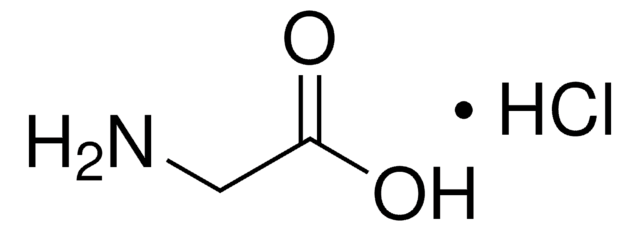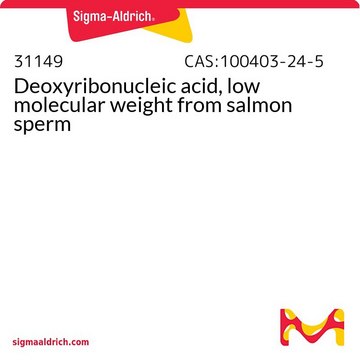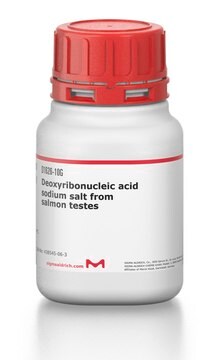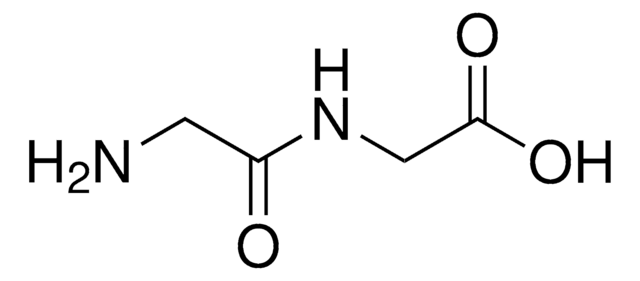Wszystkie zdjęcia(3)
Kluczowe dokumenty
G6761
Glycine sodium salt hydrate
≥99% (HPLC)
Zaloguj sięWyświetlanie cen organizacyjnych i kontraktowych
About This Item
Wzór liniowy:
H2NCH2CO2Na · xH2O
Numer CAS:
Masa cząsteczkowa:
97.05 (anhydrous basis)
Numer MDL:
Kod UNSPSC:
12352209
eCl@ss:
32160406
Identyfikator substancji w PubChem:
NACRES:
NA.77
Polecane produkty
pochodzenie biologiczne
synthetic (organic)
Poziom jakości
Próba
≥99% (HPLC)
Formularz
powder
masa cząsteczkowa
97.05 g/mol (anhydrous basis)
metody
electrophoresis: suitable
mp
197-201 °C (lit.)
ciąg SMILES
[Na+].[H]O[H].NCC([O-])=O
InChI
1S/C2H5NO2.Na.H2O/c3-1-2(4)5;;/h1,3H2,(H,4,5);;1H2/q;+1;/p-1
Klucz InChI
CIJQGPVMMRXSQW-UHFFFAOYSA-M
Szukasz podobnych produktów? Odwiedź Przewodnik dotyczący porównywania produktów
Opis ogólny
Research area: Neuroscience
Glycine is a simple non-essential amino acidIt is synthesized from choline, threonine and serine. It serves as a precursor for porphyrins, purines, glutathione and creatine.
Glycine is a simple non-essential amino acidIt is synthesized from choline, threonine and serine. It serves as a precursor for porphyrins, purines, glutathione and creatine.
Zastosowanie
Glycine sodium salt hydrate has been used as a component of buffer for homogenization of whole muscle for protein extraction and in electrophoresis buffer. It has also been used as a neurotransmitter in immunohistochemical staining of Zebrafish spinal cord sections.
Działania biochem./fizjol.
Glycine serves as a neurotransmitter in the central nervous system. It aids in increasing the quality of sleep and neurological functions. It is essential for the regulation immune function, metabolism, growth and development. Glycine modulates intracellular Ca2+ levels and cytokines production. Studies have shown that glycine treatment effectively prevents organ transplantation failure by mitigating ischemia reperfusion injury caused by cold ischemic storage. Additionally, glycine treatment also enhances graft function during transplantation. A reduction in glycine levels is observed in obesity, type 2 diabetes (T2DM), and non-alcoholic fatty liver disease (NAFLDs). Glycine is degraded to serine by glycine serine hydroxymethyltransferase 1 in cytoplasm.
Ta strona może zawierać tekst przetłumaczony maszynowo.
Kod klasy składowania
11 - Combustible Solids
Klasa zagrożenia wodnego (WGK)
WGK 3
Temperatura zapłonu (°F)
Not applicable
Temperatura zapłonu (°C)
Not applicable
Środki ochrony indywidualnej
Eyeshields, Gloves, type N95 (US)
Wybierz jedną z najnowszych wersji:
Masz już ten produkt?
Dokumenty związane z niedawno zakupionymi produktami zostały zamieszczone w Bibliotece dokumentów.
Klienci oglądali również te produkty
Glycine Metabolism and Its Alterations in Obesity and Metabolic Diseases
Alves A, et al.
Nutrients, 11(6), 1356-1356 (2019)
Multifarious beneficial effect of nonessential amino acid, glycine: a review
Razak MA, et al.
Oxidative Medicine and Cellular Longevity, 2017 (2017)
Complementary expression of calcium binding proteins delineates the functional organization of the locomotor network
Berg EM, et al.
Brain Structure &Amp; Function, 223(5), 2181-2196 (2018)
Phylogenetic relationships among five marine Catfish species (Pisces: Ariidae) from Mexico
Tenorio-Colin G, et al.
Hidrobiologica, 20(3), 266-274 (2010)
J W Johnson et al.
Nature, 325(6104), 529-531 (1987-02-05)
Transmitters mediating 'fast' synaptic processes in the vertebrate central nervous system are commonly placed in two separate categories that are believed to exhibit no interaction at the receptor level. The 'inhibitory transmitters' (such as glycine and GABA) are considered to
Nasz zespół naukowców ma doświadczenie we wszystkich obszarach badań, w tym w naukach przyrodniczych, materiałoznawstwie, syntezie chemicznej, chromatografii, analityce i wielu innych dziedzinach.
Skontaktuj się z zespołem ds. pomocy technicznej






